Angkor Wat Cambodia – Everything About It
Angkor Wat, Cambodia is the largest temple complex of the world. The city where the temple was built, Angkor (meaning city in Khmer), is located in Siem Reap, and was once the capital of the Khmer Empire. This city contains hundreds of temples. It is said that in its prime, Angkor had a population of around 1 million. Angkor Wat was originally built as a Hindu temple dedicated to God Vishnu. It was converted into a Buddhist temple in the 14th century, and many statues of Buddha were added to its already rich artwork. Sometime later it was turned into a military fortification. Angkor Wat today is the main tourist attraction of Cambodia and also features in the Cambodian National flag.
Structure, Symbol and Science
The influence of Hindusim is evident from the layout of Angkor Wat. The temple layout of one tall central tower surrounded by four smaller towers and a series of enclosures recreates the image of Mount Meru, a legendary place in Hindu mythology that is said to lie beyond the Himalayas and is supposed to be the home of the Gods. Angkor wat is a miniature replica of the universe in stone and represents an earthly model of the cosmic world (as stated in Hindusim). The central tower rises from the centre of the monument symbolizing the mythical mountain, Mt Meru, situated at the centre of the universe. Its five towers correspond to the peaks of Mt Meru. The outer wall corresponds to the mountains at the edge of the world, and the surrounding moat the oceans beyond. Angkor Wat’s main entrance was to the west (a direction associated with Vishnu) across a stone causeway, with guardian lions marking the way. The seven-headed naga(mythical serpent) becomes a symbolic rainbow bridge for man to reach the abode of the gods.
Angkor Wat is surrounded by a 650-feet-wide moat creating a boundary of more than 5km. While the legend says that moat represents the oceans surrounding Mt Meru, it is possible that this 13 feet deep moat was dug to help stabilize the temple’s foundation, preventing groundwater from rising too high or falling too low.
King Suryavarman & Lord Vishnu
Angkor Wat was built by King Suryavarman II, who rose to power in his teens, by killing his uncle, Dharanindravarman I. Suryavarman II was an ardent follower of Vishnu and he installed the statue of Vishnu in Angkor Wat’s Central tower. That he revered Vishnu is also evident from the Samudra Manthan ( Churning of the Ocean) episodes depicted on the walls of the temple.
Samudra Manthan is a legend from Hinduism. It describes how the Devas (gods) and the Asuras (demons) churned the ocean under the aegis of Vishnu, to produce the divine elixir of immortality ( Amruta). Besides, there are a lot of stories from the epics Ramayana and Mahabharata which adorn the temple walls.
Suryavarman’s devotion to Vishnu is also shown in the posthumous name he was given, “Paramavishnuloka” which, means “he who is in the supreme abode of Vishnu.”
Although Angkor Wat is dedicated to Vishnu, many believe that it was built for funerary purposes. Symbolically, west is the direction of death, and hence it led a large number of scholars to conclude that Angkor Wat must have existed primarily as a tomb since it is aligned to the west direction. This idea was supported by the fact that the magnificent bas-reliefs of the temple were designed to be viewed in an anticlockwise direction, a practice that has precedents in ancient Hindu funerary rites. God Vishnu, however, is also frequently associated with the west direction, and it is now commonly accepted that Angkor Wat most likely served both as a temple and as a mausoleum for Suryavarman II.
Inside Angkor Wat
There are more than three thousand Apsaras or Celestial Nymphs carved on the walls of Angkor Wat. Each of them is unique with a different hair do, jewellery and posture. Many of these Apsaras have been damaged due to exposure to chemicals and bat dropping.
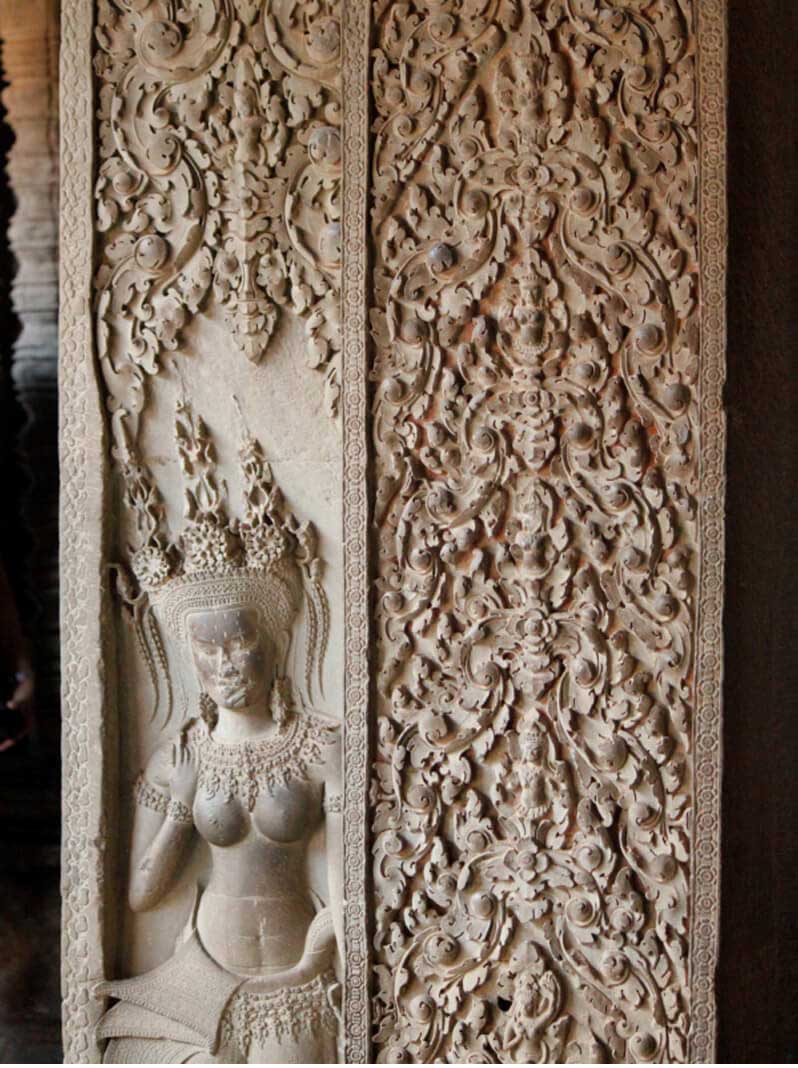
Stretching around the outside of the central temple complex is an 800m-long series of intricate carvings depicting historical events and stories from mythology. It is said that the spatial dimensions of Angkor Wat parallel the lengths of the four ages (Yuga) of classical Hindu thought. Thus the visitor to Angkor Wat who walks the causeway to the main entrance and through the courtyards to the final main tower, which once contained a statue of Vishnu, is metaphorically travelling back to the first age of the creation of the universe.
Outer Wall
The rectangular outer wall, has a gate on each side, but the main entrance, a 235m-wide porch richly decorated with carvings and sculptures, is on the western side. There is a statue of Vishnu, 3.25m in height, carved from a single block of sandstone, located in the right-hand tower. Vishnu’s eight arms hold a mace, a spear, a disc, a conch and other items.
Boulevard & Central Complex
The boulevard is lined with naga railing, leading from the main entrance to the central temple, passing between two graceful libraries and then two pools. The central temple complex consists of three storeys, each made of laterite, which enclose a square surrounded by intricately interlinked galleries. The Gallery of a Thousand Buddhas (Preah Poan) used to house hundreds of Buddha images before the war, but many of these were removed or stolen. The corners of the second and third storeys are marked by towers, each topped with symbolic lotus-bud towers.
Upper Level
The stairs to the upper level are immensely steep. Also known as Bakan Sanctuary, the upper level of Angkor Wat is open to a limited number per day with a queuing system.
Some of the Bas-Reliefs in Angkor Wat
Most of the Bas reliefs are inspired from Indian mythology centred around Vishnu and his reincarnations.
a)Samudra Manthan (Churning of the Ocean)
The southern section of the east gallery adorns the Samudra Manthan or the Churning of the Ocean episode. This carving depicts 88 asuras on the left, and 92 devas, with crested helmets, churning up the sea to extract from it the elixir of immortality (Amruta). The demons hold the head of the serpent Vasuki and the Gods hold its tail. At the centre of the sea, Vasuki is coiled around Mt Mandara, which turns and churns up the water in the tug of war between the demons and the gods. Vishnu, incarnated as a huge turtle, lends his shell to serve as the base and pivot of Mt Mandara. Brahma, Shiva, Hanuman (the monkey God) and Lakshmi (the Goddess of wealth and prosperity) all feature in the carvings.
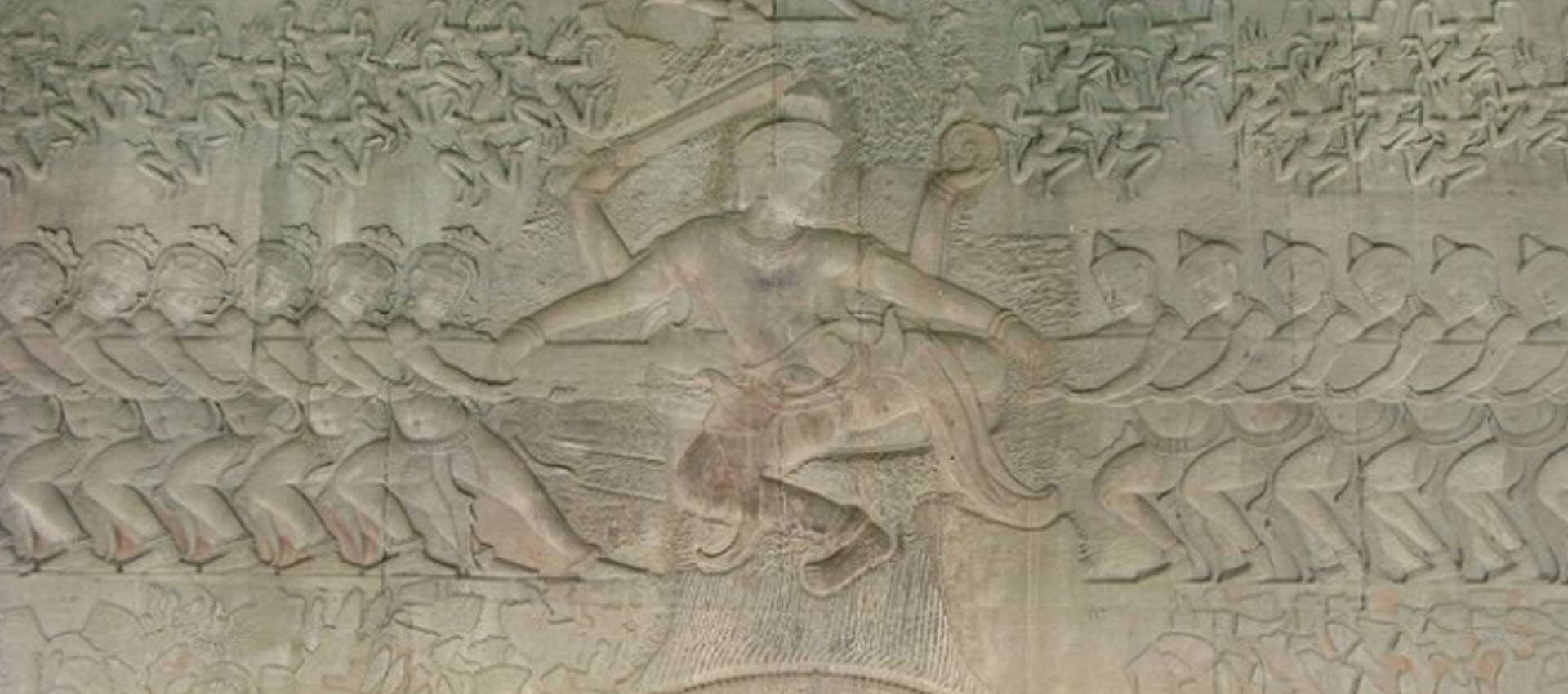
b)Battle of Kurukshetra
The southern portion of the west gallery depicts a battle scene from the Hindu epic Mahabharata , fought between the Kauravas and the Pandavas. Infantry is shown on the lowest tier, with officers on elephants, and chiefs on the second and third tiers. Also depicted is the episode of Bhishma from the Kauravas side lying on the bed of arrows.
c)Battle of Lanka
The northern half of the west gallery shows scenes from the Hindu epic Ramayana. These are the scenes from the Battle between Rama (reincarnation of Vishnu) and Ravana, the emperor of Lanka. Ravana had held Rama’s wife as captive.
d)Heaven & Hell
The punishments and rewards of heavens and hells are depicted in the eastern half of the south gallery. On the left, the upper and middle tiers show men and women proceeding towards Yama (the God of Death) seated on a bull. On the lower tier, devils drag the wicked along the road to hell.
e)Gods & Demons
The western section of the north gallery depicts the battle between the Gods and various demons. The Gods are depicted with their traditional attributes and mounts. Vishnu has four arms and is seated on a garuda (bird), while Shiva rides a sacred goose.
Temple rules
Temples of Angkor are a sacred site for the locals and Hindus and Buddhist across the world. All visitors are required to dress appropriately.

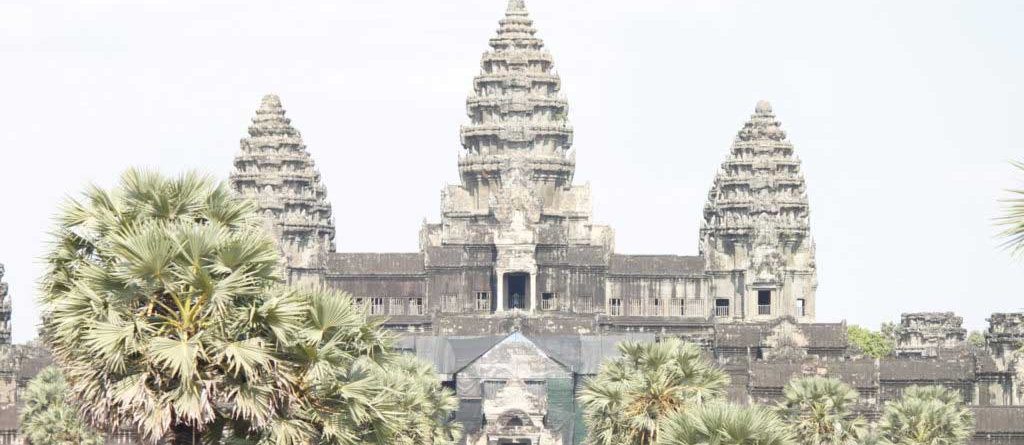

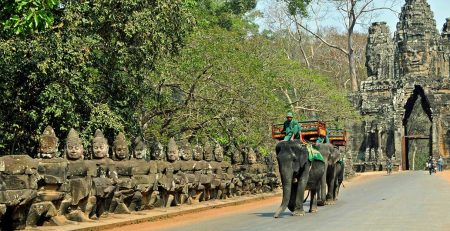
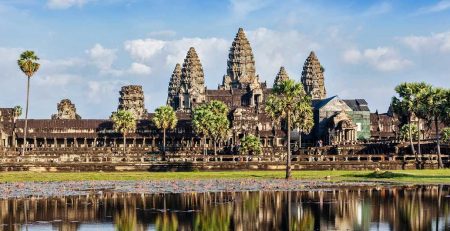


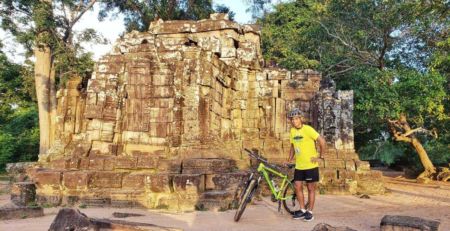
Leave a Reply